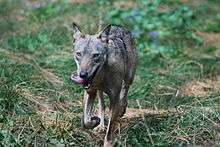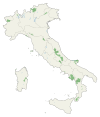Parco Nazionale d'Abruzzo, Lazio e Molise
| Parco Nazionale d'Abruzzo, Lazio e Molise | |
|---|---|
|
IUCN category II (national park) | |
|
A view of the National Park of Abruzzo, Lazio and Molise | |
 | |
| Location | Abruzzo, Lazio, Molise |
| Nearest city | Rome |
| Area | 496.80 km2 (191.82 sq mi) |
| Established | 1922 |
| Governing body | Ministero dell'Ambiente |
| http://www.parks.it/parco.nazionale.abruzzo/Eindex.html | |
Parco Nazionale d'Abruzzo, Lazio e Molise (English: National Park of Abruzzo, Lazio and Molise, often cited under its previous name, Abruzzo National Park) is an Italian national park founded in 1922. The majority of the park is located in the Abruzzo region though it is not constrained by regional boundaries and also includes territory in Lazio and Molise. The park headquarters are in Pescasseroli in the Province of L'Aquila. The park currently includes 496.80 km2 (191.82 sq mi).[1]
The oldest in the Apennines, with an important role in the preservation of species such as the Italian wolf, Abruzzo chamois and Marsican brown bear, the park is around two thirds beech forest though many other trees grow in the area including the silver birch and black and mountain pines. Other characteristic fauna of the park are roe deer, wild boar and the white-backed woodpecker.
History
The idea for the Abruzzo National Park arose in the years following World War I thanks to the work of Erminio Sipari, environmentalist, member of Italian Parliament and cousin of Benedetto Croce.[2] Between the months of October and November 1921, the municipality of Opi leased 5 square kilometres of land to a private federation with the aim of protecting flora and fauna and Sipari founded in Rome an organization to administer the reserve.[3] So the Park was founded on September 1922.[4] Over the next few years the territory of the park expanded into neighbouring municipalities until it covered around 120 km² by 1923, when protection was enshrined in law. A period of intense activity followed and the park had further expanded to around 300 km² when it was abolished by the Fascist government in 1933.
Re-establishment of the park in 1950 coincided with a period of financial difficulty, followed by a building boom which saw more than 12,000 trees felled for the construction of houses, roads and ski tracks. A reorganisation of the park management at the end of the 1960s heralded better times and by 1976 further expansion, to 400 km², followed at the request of villages in neighbouring Molise, that were convinced by the economic benefits of the park. Today, at 500 km², the area of the park is 100 times larger than the original reserve.
Geography
The mountains within the park are Petroso (2,249 metres), Marsicano (2,245 metres), Meta (2,242 metres), Tartaro (2,191 metres), Jamiccio (2,074 metres), Cavallo (2,039 metres), Palombo (2,013 metres).[5] These are included in the Monti della Meta. The Sangro River rises near Pescasseroli and runs south-east through the artificial Lago di Barrea before leaving the park and turning to the north-east. Other rivers in the park are the Giovenco, Malfa and Volturno. Other lakes are Vivo, Pantaniello, Scanno, Montagna Spaccata, Castel San Vincenzo, Grottacampanaro, and Selva di Cardito.
Animals

In wildlife terms, the main attractions of the park are the Marsican brown bear and Italian wolf. While official figures report 70-100 bears in this genetically isolated population, the declining population is actually estimated at closer to 30.[6] The shift from local agriculture to development in Abruzzo (including a controversial proposed ski resort) and poaching, threaten this remaining small population.[7] While Wolves were once rarer (as low as 40), numbers have reportedly rebounded in recent years.[8]
The elusive Eurasian lynx is present in the park, very rarely seen but heard calling.
In greater numbers, though no easier to spot, are red deer and roe deer, and the reintroduced wild boar, which live in the thicker areas of the forest. Other reclusive inhabitants of the forest include European polecat, badger, Eurasian otter and two species of marten; pine marten and beech marten. Higher, above the forest, chamois live alone or in small groups.
Animals that are easier to see include red fox, the mountain hare, the least weasel, the European mole, and the western European hedgehog. Dormice and red squirrel s are also quite frequently seen. Other mammals recorded in the park are the snow vole, the edible dormouse, the wildcat and an introduced species the crested porcupine whose quills may be seen on paths.
Birds
Many birds of prey inhabit the park. Most notable amongst them is the golden eagle which, despite living in the more inaccessible regions, can often be seen soaring over central areas of the park in search of prey such as small mammals or even sick, young chamois. Other raptors that reside within the park include goshawks, peregrine falcons, Eurasian buzzards, kestrels and Eurasian sparrowhawks. Less visible, but perhaps more audible, to the nighttime visitor are several species of owl, the little owl, the barn owl and the tawny owl. Woodland birds include the European green woodpecker and the rare white-backed woodpecker, cliffs harbour the red-billed chough and alpine chough and bare mountain birds include the rock partridge and white-winged snowfinch. streams provide habitat for the grey wagtail and white-throated dipper.
Plants
The flora of the park is rich and interesting. A comprehensive list of plants would extend to more than 2,000 species without including lichens, algae or fungi. Flowers present in the area include Marsian Iris (Iris marsica),[9] gentian, primrose, cyclamen, violets and the lily. The most well-known flower of the park is the rare lady's slipper (Cypripedium calceolus), a yellow and black orchid.
The predominant tree of the park is the beech which covers 60% of the area, generally grows at 900–1800 m altitude and provides a stunning display of colour throughout the whole year. Other notable trees are the black pine, the mountain pine and the silver birch.
Municipalities
The park covers 25 municipalities, distributed across 3 provinces.[5]
Province of L'Aquila:
- Alfedena, Barrea, Bisegna, Civitella Alfedena, Gioia dei Marsi, Lecce nei Marsi, Opi, Ortona dei Marsi, Pescasseroli, Scanno, Villavallelonga, Villetta Barrea
Province of Frosinone:
- Alvito, Campoli Appennino, Pescosolido, Picinisco, San Biagio Saracinisco, San Donato Val di Comino, Settefrati, Vallerotonda
Provincia of Isernia:
Activities
Many outdoor activities are possible within the park including,
See also
References
- ↑ "Parco Nazionale d'Abruzzo, Lazio e Molise". parks.it. 2004–2010..
- ↑ Luigi Piccioni, Erminio Sipari. Origini sociali e opere dell'artefice del Parco Nazionale d'Abruzzo, University of Camerino 1997; James Sievert, The Origins of Nature Conservation in Italy, Peter Lang (publishing company), Bern 2000, pp. 165-181; Marco Armiero - Marcus Hall (ed.), Nature and History in Modern Italy, Ohio University 2010
- ↑ "Parco Nazionale d'Abruzzo, Lazio e Molise". parcoabruzzo.it. 2011.
- ↑ Lorenzo Arnone Sipari, Il Parco Nazionale d'Abruzzo liberato dall'allagamento. Un conflitto tra tutela ambientale e sviluppo indutriale durante il fascismo, "Rivista della Scuola Superiore dell'Economia e Finanza", 2003, nr. 8-9: 27-39; Lorenzo Arnone Sipari (ed.), Scritti scelti di Erminio Sipari sul Parco Nazionale d'Abruzzo (1922-1933), Trento 2011.
- 1 2 "The National Park of Abruzzo, Lazio e Molise". NAP - Network of Adriatic Parks. Archived from the original on 2009-04-10.
- ↑ Paynton, Brian (2006). In Bear Country. Old Street Publishing, London. ISBN 978-1-905847-14-3.
- ↑ Hooper, John (2004-08-24). "Italy battles to save the last of its wild bears". The Guardian. Retrieved 2007-08-16.
- ↑ "Wolves at Florence's gates". Italy Magazine. Retrieved 2007-08-16.
- ↑ "The Abruzzo National Park". opionline.it. Retrieved 28 October 2015.
External links
| Wikimedia Commons has media related to National Park of Abruzzo, Latium and Molise. |
- "Official website" (in Italian).
- "Italy - Abruzzo, Lazio and Molise National Park". Wild Zone.
- Fletcher, Adrian (2000–2010). "Parco Nazionale d'Abruzzo". paradoxplace.com.
Coordinates: 41°45′51″N 13°52′08″E / 41.76417°N 13.86889°E

